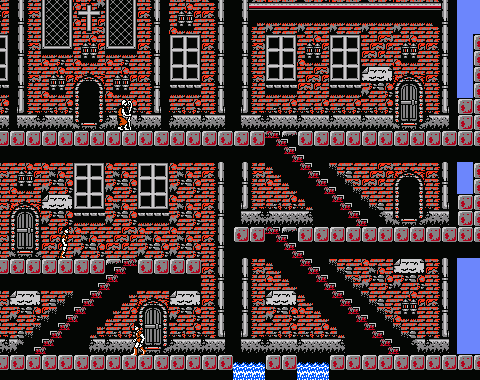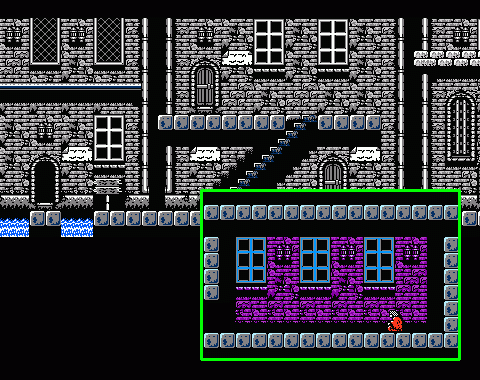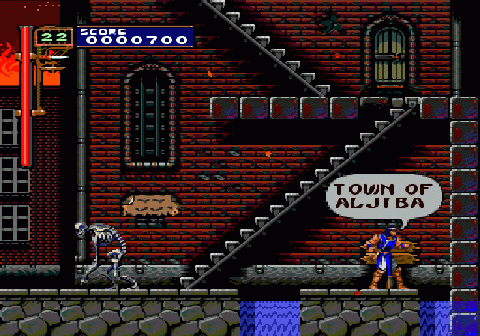So, towns.
Simon’s Quest breaks its world, effectively, into three play spaces: Towns, the Transylvanian countryside, and Mansions. Each operates by its own rules, although the general means by which Simon navigates them remains consistent. It’s not like a tactical RPG where you have battlefields, towns, and a world map, each of which you deal with in a different way. The sidescrolling platformer rubric holds fast everywhere.

This, of course, makes for some very silly-looking towns when you stop and think about it: Stacked, three-story façades, like high-rise strip malls in the middle of the forest. But, you know, 8-bit limitations and all that. You make your allowances and accept the fact that this is surely meant to represent a more logical, real-world construction.
Towns in Simon’s Quest work exactly like you’d expect to see in an RPG (EXCEPT FINAL FANTASY XIII LOL… sigh). They’re combat-free zones where you can speak with NPCs, recover health in a centrally located church, and find merchants who’ll sell you essential goods. They’re not entirely without hazards; the platforms seem to have been designed specifically for the purpose of sending you plummeting to your death in the river if you miss a jump.
Also, towns (more than any other space in the game) reflect the day/night cycle; villagers only walk around during daylight. At night, zombies appear. Zombies suck. They offer no meaningful experience points and very little cash, but they cause NPCs to shutter their doors. Towns effectively become worthless at night; Simon can’t even trade with merchants or stop in the church. What kind of crappy church keeps banker’s hours? This is exactly why we needed the Protestant Reformation.
Simon’s Quest begins in the town of Jova. Coincidentally, the game’s problems also begin in Jova. Well, maybe “problems” is too strong a term, but it’s here that you get a sense of how unconventional Simon’s Quest will turn out to be. With no preamble or foreword (aside from an attract mode enticing you to “step into the shadows of the hell house” — no thanks?), Simon finds himself simply plopped down in a village where old people wander aimlessly and a weird, low-tempo, almost harmonica-like variation on “Vampire Killer” plays. You can easily fall into the water and die. Most of the people you talk to make no sense or outright lie to you. There are no immediate threats. No score or stage info appears, only a discreet health meter. You can’t whip the candelabras! What kind of mad world is this?
At the same time, you have just enough time to thoroughly explore Jova and get a sense of how things work before the game’s first nightfall, so despite the initially discombobulating sense you take away from the beginning of the game it does its job quite nicely without ever leading you by the hand. “Discovery” is the keyword here. You begin near the west/left edge of town, but should you head out that direction you will quickly discover what a bad idea that is: A pair of powerful, two-headed, fire-breathing monsters will smash into you and throw you back into town with damage recoil before your feeble starting whip can hope to take them down. It’s not fatal, and the church “upstairs” will allow you to recover, but the message is clear: Don’t go left yet.
Inside of Jova, you find yourself forced to make your first interesting decision. You can buy three items in Jova in total — the Holy Water, the White Crystal, and the Thorn Whip — but the sum cost is 200 hearts. You begin with 50: Enough to buy either the crystal or Holy Water, but not both. The first time you play, you won’t know what either item does, so it’s all more or less the same and you’ll mostly likely stand around to the east of town farming cash. In subsequent playthroughs, however, you’ll know both the purpose of each tool and about the overall game time limit as well, so you’ll have to decide which to take right away and when it’s best to return. The Holy Water is probably the most useful tool in the game and has value almost immediately, but unless you’re very lucky or very good at memorization, you need the White Crystal to complete the first mansion. These tradeoffs in the name of efficient play help make Simon’s Quest interesting to revisit.
By and large, every town more or less takes the form of Jova. Some are bigger than others, some smaller. Some have hidden merchants. Some have more helpful citizens than other. The most interesting town, I think, is Ghulash…

…an almost completely abandoned village immediately outside Dracula’s castle. It’s desolate and grey (surely inspired by Dragon Quest‘s town of Haukness), with the cemetery immediately outside its western walls considerably larger than the town itself. The one resident of Ghulash is a crazy man who invites you to live there with him. Uh… thanks for the offer, dude.

Of course, this badly contradicts Rondo of Blood. No wonder Konami treated that game as apocrypha!
Which game are you saying Konami treated as apocrypha? Both Simon’s Quest and Rondo of Blood are referenced in subsequent games (Symphony of the Night has the five Dracula parts from SQ and too many RoB callbacks to enumerate, for example).
@Legion For all intents and purposes, they’re all apocrypha now. But I was referring to the way the company put its eggs in the Castlevania 64 basket and let the Symphony team do whatever they wanted since they didn’t see it as the true continuation of the series.
The towns in Castlevania II are pretty odd. The day/night cycle keeps running as long as you’re not inside a building, potentially having the shops close and the zombie brigade show up when you just get into town or while you’re in the process of exploring one. The villagers that tell you the truth make almost as little sense as those that tell blatant lies, especially if you’re a new player. And you can die from the water hazards, which I would imagine to be very frustrating if a player somehow got a Game Over before buying anything and lost his/her hearts.
As for Water vs. Crystal, I consider the holy water a better first purchase, if only for its value as a block breaking and false block finding tool. It’s pretty useful for some of the homing fireball mermen at the broken bridge, too.
But, if I was trying to do a legit seven days or less run instead of password exploitation, I’d probably go for the white crystal. Not because of the first mansion’s invisible floating platform, but because it’s required to trade for the blue crystal later on, and you can’t just get past the lake with a leap of faith.
What was the contradiction in Rondo? Was it placing Aljiba as the town outside of Castlevania instead of Jova? It’s been a while, so I don’t remember.
@LBD Just like it says in the update. The town outside of the castle in Simon’s Quest is Ghulash, but it’s Aljiba in Rondo. Not a big deal, just an interesting minor inconsistency.
@jparish A town named Aljiba, that looks closer in design and color palette to Jova, placed right in Dracula’s backyard like Ghulash.
Yeah, whoever added the Castlevania II reference didn’t really think this through.
Ah, sorry, I meant to say Ghulash.